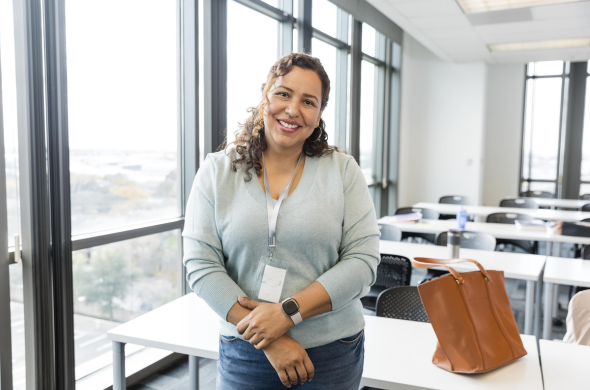10 Summer Tips to Prepare a Great Classroom
Creating a great classroom involves thoughtful planning and preparation to ensure the space is welcoming, engaging, and conducive to learning. Here are some steps you can take during this summer to set up the perfect classroom:
1. First and Foremost: Self Care
Rest and Recharge
You just finished a marathon school year. It is important to rest and recharge during the summer break. A well-rested teacher is essential for creating a calm and positive classroom environment.
2. Planning and Vision
Reflect on the Previous Year
When you feel ready to think about it, assess what worked well and what didn’t in your classroom layout and environment. Start planning how your new classroom will look and function early in the summer so you aren’t stressed about time before school starts.
Set Goals
Determine what you want to achieve with the new classroom setup. Consider factors like fostering collaboration, encouraging independent work, and creating a calming atmosphere.

3. Classroom Layout and Furniture
Flexible Seating
Incorporate a variety of seating options, like traditional desks for seat work time, bean bags for the class library, other types of seating for listening, art, and science centers, and floor cushions to accommodate different learning styles and other center activities. Many people donate these items during the early summer months, so this is the perfect time to look for them!
Defined Areas
Create specific zones for different activities, such as a reading corner, a group work area, and an art station. Use rugs, shelves, or furniture to define these spaces.
Accessibility
Ensure that all materials and resources are easily accessible to students. Low shelves and labeled bins can help you organize your classroom.

4. Decor and Atmosphere
Theme and Color Scheme
Choose a theme and overall look and feel for your classroom. Avoid overly bright or distracting colors in your color scheme. Colors like blue and green help the classroom feel calm and peaceful.
You can find many affordable decorations to fit your theme on teacher resource websites. These sites can also help you brainstorm ideas for your classroom.
Natural Elements
Incorporate plants and natural light as much as possible to improve air quality and create a more inviting atmosphere. Soft lighting and lamps can help you make such cozy corners in your room. I found that my students worked much better when we turned off the bright fluorescent lights and used the softer lighting I had stationed around the room.
Student Work Displays
Designate areas to display student work to boost their pride and ownership of the space.
5. Organization
Storage Solutions
Use bins, baskets, and organizers to keep supplies and materials tidy. Label everything clearly to help students easily find and return items.
Supply Stations
Create stations for commonly used supplies like pencils, scissors, and paper to reduce disruptions and encourage independence. To help younger students, use picture labels on bins and drawers.
Technology
If you use technology like headphones, tablets, and laptops in your classroom, make sure they have a dedicated storage space and that charging stations and cords are neatly stored and managed.

6. Engaging Learning Materials
Learning Resources
Stock the classroom with books, games, and learning materials that cater to different interests and reading levels. Start searching now in the early summer for new finds to add to your centers and class library!
Interactive Elements
Include interactive bulletin boards, learning centers, and hands-on materials to keep students engaged. Share a wish list with families and friends in case they are willing to donate towards classroom supplies and other items needed.
7. Community Areas
Welcome Area
Create a welcoming area near the classroom entrance where students can see positive messages, daily schedules, and class information. This area can include your gathering rug, morning board, and information about job helpers and birthdays. This area sets the tone for all you do and learn together.
Collaborative Spaces
Designate areas where students can work together on projects. These areas should include large tables or clusters of desks.

8. Calm and Focus Zones
Quiet Areas
Set up a quiet corner where students can go to read or take a break if they need a moment to themselves.
Sensory Tools
Provide tools like noise-canceling headphones or fidget toys to help students who may need sensory input to focus.

9. Professional Development
Workshops and Training
Attend workshops or training sessions now to gain new ideas and strategies for classroom management and design.
Networking
Connect with other educators to share ideas and gain inspiration! Other teachers can share what works for them and tips and tricks they have learned when putting together their classrooms.

10. Personal Touch
Personalize the Space
Add personal touches that reflect your personality! Photos of your family, inspirational quotes, or decorations related to your hobbies and interests can make the space more personal. Your students will also enjoy getting to know you better and building connections with you.
Your classroom is a great tool! Focus on these areas to create a well-organized, engaging, and effective learning environment for your students.
Warmly,
Debbie
 Debbie Bagley works as a Studies Weekly Teacher Advocate. Teacher Advocates are former teachers who help teachers like you implement Studies Weekly materials into their instruction. Teacher Advocates are available to provide support through email, phone call, video chat, and regularly scheduled Teacher Talk Webinars on Tuesdays and Thursdays. Teacher Advocates are only available for classroom teachers currently using Studies Weekly materials. They are not available for homeschools.
Debbie Bagley works as a Studies Weekly Teacher Advocate. Teacher Advocates are former teachers who help teachers like you implement Studies Weekly materials into their instruction. Teacher Advocates are available to provide support through email, phone call, video chat, and regularly scheduled Teacher Talk Webinars on Tuesdays and Thursdays. Teacher Advocates are only available for classroom teachers currently using Studies Weekly materials. They are not available for homeschools.